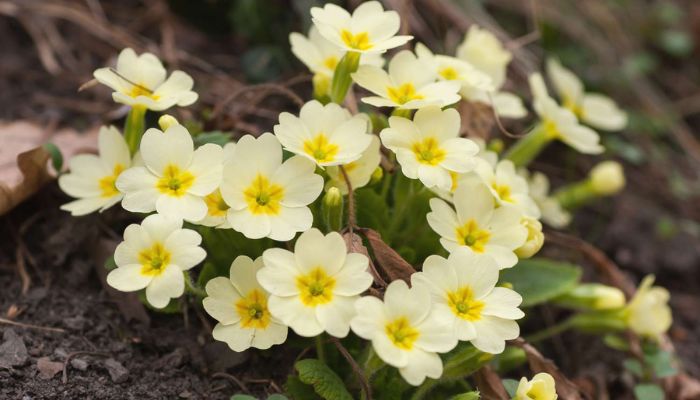Where to Plant Primroses?
Primroses aren’t overly demanding when it comes to their planting spot, yet selecting the right location is pivotal for their well-being.
Primroses flourish in:
- Moist, well-draining soil: Ensure the soil is rich in organic matter and drains effectively to prevent waterlogged roots.
- Partially shaded areas: Primroses prefer dappled sunlight or indirect light, avoiding full sun exposure that can harm their delicate foliage.
- Borders, rock gardens, or woodland settings: These settings emulate their natural habitats, providing ideal conditions for primroses to thrive.
When to Plant Primroses?
Planting from Seed or Young Plants?
The primary consideration when planting primroses revolves around whether you’re starting from seed or transplanting young plants.
- Transplanting young primroses: Typically, spring is the ideal time for planting purchased young primroses, as they become available in garden centers during this season.
- Autumn planting: While it’s possible to plant primroses in the autumn, finding them for sale may be challenging, so spring planting is more common.
- Growing from seed: For successful seed germination, begin in autumn. Start seeds indoors in a greenhouse, polytunnel, or cold frame, especially in cooler climates. Warmer regions may allow direct outdoor sowing.
Sun or Shade Preferences?
Understanding a plant’s sunlight preferences is vital for its well-being. Primroses, in particular, have a penchant for shade.
Primroses thrive in:
- Partial to full shade: In hot climates, they benefit from increased shade, while cooler regions can tolerate a bit more sunlight.
- Morning sun and afternoon shade: The gentler morning sunlight is less likely to harm the plants.
Optimal Temperature for Primroses
Temperature plays a pivotal role in primroses growth and blooming, as these plants are renowned for their cool-season resilience.
Primroses thrive in:
- Cool to temperate climates: Primroses favor temperatures ranging from 45°F to 65°F (7°C to 18°C).
- Winter chill requirement: Many primrose varieties necessitate a period of winter cold to stimulate spring flowering.
- Protection from extreme cold: In harsh winter conditions, provide mulch or cover to shield primroses from freezing temperatures.
How Fast Do Primroses Grow?
Primroses are not known for rapid growth but possess unique qualities that make them special in the gardening world.
- Slow and steady growth: Primroses exhibit a slow growth rate, taking their time to establish roots and produce blooms.
- Early spring blooming: Their ability to bloom in early spring, when many other plants are still dormant, sets primroses apart.
- Diverse variety: With numerous species and hybrids available, primroses offer a wide range of colors, sizes, and forms to complement any garden design.
- Perennial beauty: With proper care, primroses can grace your garden with seasonal beauty for several years.
Can Primroses Be Houseplants?
Although primarily grown outdoors, primroses can also thrive indoors as charming houseplants.
- Indoor primroses: Many gardeners bring primroses indoors during winter to enjoy their vibrant blooms and captivating colors.
- Indoor care tips: To successfully grow primroses indoors, ensure they receive bright, indirect light, maintain consistent moisture levels, and shield them from drafts.
How Long Do Primrose Flowers Last?
Primrose flowers have a relatively short but enchanting blooming period.
- Blooming duration: Typically, primrose flowers brighten your garden or indoor space for several weeks during the early spring months.
- Deadheading: Regularly removing spent blossoms can extend the blooming period and encourage the plant to produce more flowers.
Troubleshooting: Why Is My Primrose Struggling?
If your primrose isn’t thriving, it’s essential to troubleshoot potential issues.
- Overwatering: Prevent waterlogged soil by ensuring proper drainage and allowing the top inch of soil to dry between waterings.
- Poor drainage: Inadequate drainage can lead to root rot; plant primroses in well-draining soil or containers with drainage holes.
- Sunburn: Shield primroses from direct sunlight to prevent scorching of leaves.
- Pests and diseases: Keep a vigilant eye for common primrose pests like aphids, slugs, and diseases like powdery mildew, addressing issues promptly.
Primroses vs. Roses
Despite the similar-sounding names, primroses and roses belong to different plant families and exhibit distinct characteristics.
- Different plant families: Primroses belong to the Primulaceae family, while roses are part of the Rosaceae family.
- Primroses are distinct in that they are perennial herbs that bloom in the early spring and have a low, rosette-like growth habit. Roses, on the other hand, are woody bushes or climbers that feature a wide variety of blooms that open at different times.
Planting Primroses in Containers
Primroses may be grown successfully in pots and containers, which is ideal for gardeners who lack access to outdoor space or who want to bring these lovely flowers indoors.
- To avoid waterlogging and ensure the health of your primroses, choose containers with enough drainage holes.
- Soil with good drainage: Use a potting soil with good drainage to avoid a problem with root rot.
- Allow enough room between plants when planting many primroses in a single pot.
Primroses, if kept indoors in a pot, should be placed next to a window that lets in lots of bright, indirect light. - Primroses grown in pots on a patio or porch require a shady location and some protection from freezing temperatures in the winter.
Conclusion:
This detailed manual reveals everything you need to know about When to Plant Primroses, from the ideal conditions for planting to the ideal temperature range. Whether you’re a seasoned green thumb or just starting out, these fundamentals will help you grow healthy, beautiful primrose plants year after year.
Feel free to plant these wonderful perennials in your garden and enjoy the distinctive beauty they provide to your outdoor and interior spaces. Enjoy your gardening!

